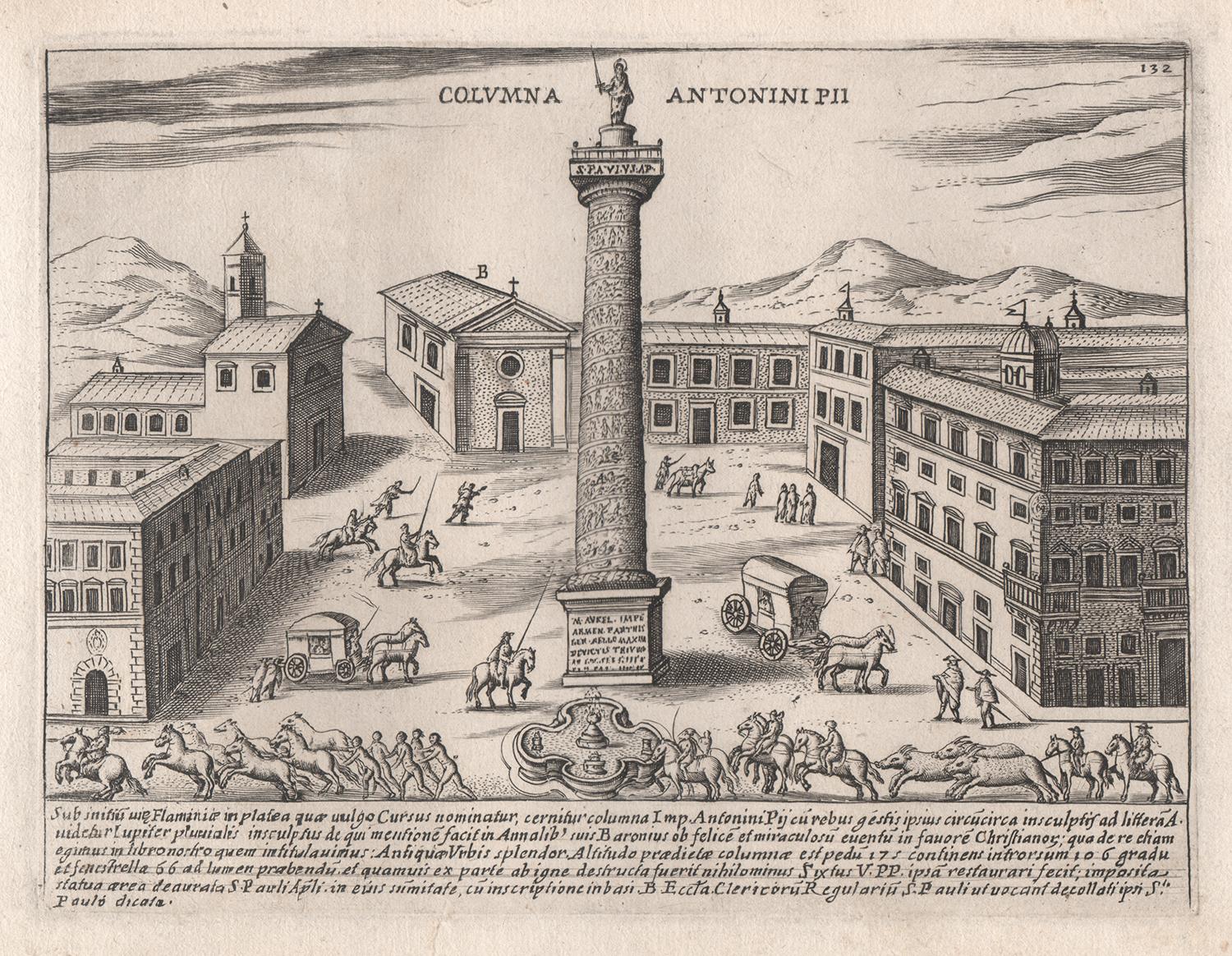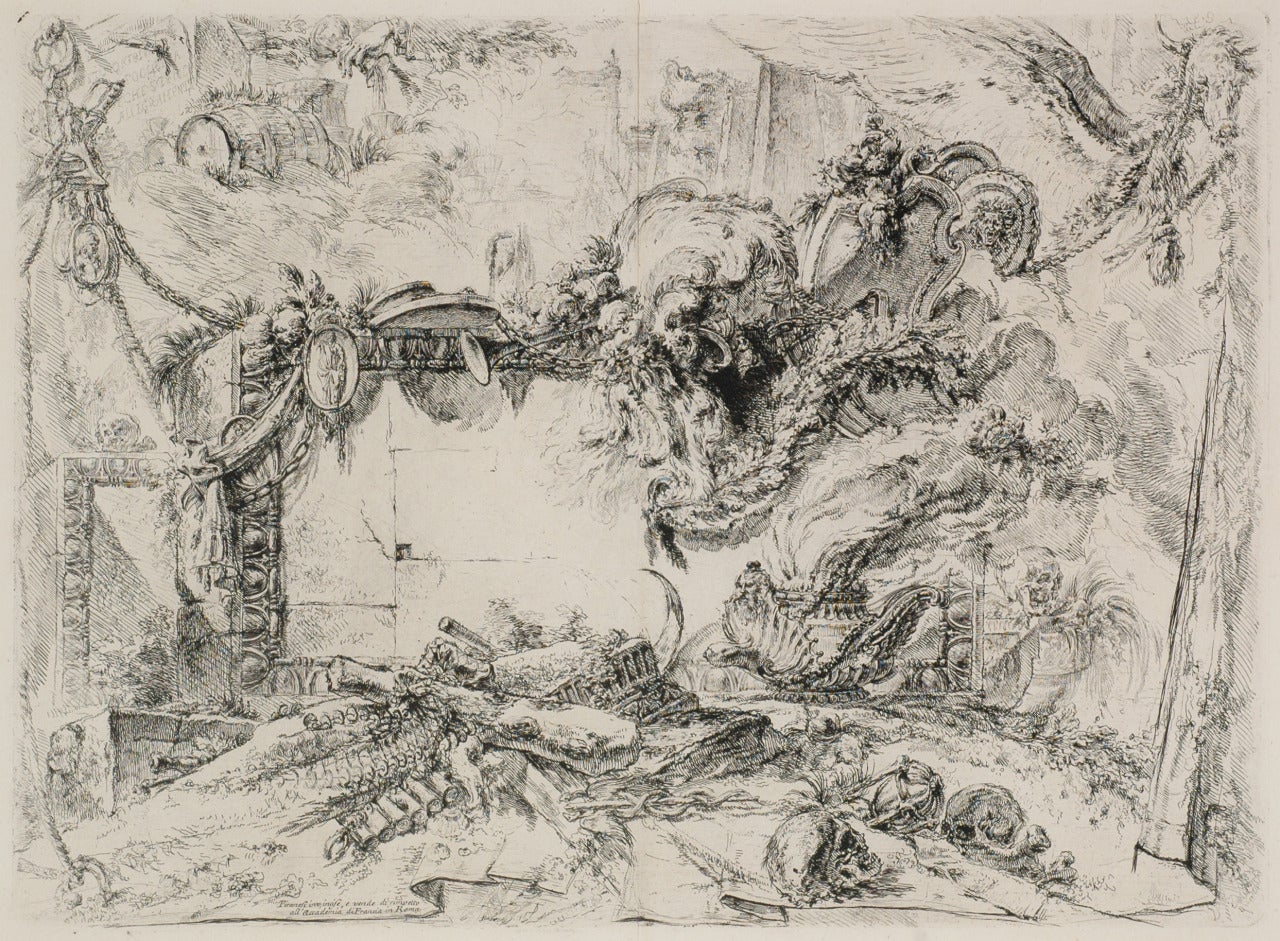Items Similar to View of the Ancient Structure built by Tarquinius Superbus called the Bel Lido
Want more images or videos?
Request additional images or videos from the seller
1 of 10
Giovanni Battista PiranesiView of the Ancient Structure built by Tarquinius Superbus called the Bel Lido1750-1778
1750-1778
About the Item
View of the Ancient Structure built by Tarquinius Superbus called the Bel Lido, and like others built by Marcus Agrippa in the time of Augustus when he cleaned all the sewers leading to the Tiber [The Cloaca Maxima], from Vedute di Roma (Roman Views), part II
Etching, c. 1750-1778
Signed: Cav. Piranesi F. lower right of plate
Series/Portfolio: Vedute di Roma
A very late Roman printing,
No visible watermark
According to Andrew Robison "As for no watermark at all, it does occasionally happen, more often in French printings than Italian, but not exclusively so. You are doing exactly the right thing to focus on the distinctive characteristics of the paper: on the whole the late 18th-century Italian paper is more pebbly on the surface, frequently thicker, and almost always more sized and polished, whereas the 19th-century French paper is softer, more flexible, and more blotter-like on the surface." (4/3/2023 email)
Inscription: At lower left: VEDUTA delle antiche Sostruzioni fatte da Tarquinio Superbo dette il Bel Lido, o come altri erette da Marco Agrippa à tempi di / Augusto, in occasione, ch'Egli fece ripurgare tutte le Cloache fino al Tevere. A Sbocco della Cloaca Massima al medesimo Fiume.
At lower right: B Tempio di Cibele, co come altri d'Ercole, il quale era situato nell'antico Foro Boario. C Avanzi delle antiche / D Monistero e Chiesa di S. Alessio. E Priorato della Sagra Religione di Malta. Saline. / Cav. Piranesi F.
Before the numbers 57 lower right margin and 741 upper right of image
Printed on a heavy, pebbled laid paper, without watermark
Clearly a Roman printing during the artist's lifetime.
Condition: Excellent
Full sheet with centerfold and paper tipping hinge verso
Image/Plate size: 17 1/2 x 26 3/8 inches
Sheet size: 22 3/16 x 31 3/4 inches
Annotated "44" verso in ink
four small bits of hinge residue recto
A rich impression with the darks providing strong contrasts and the lightly etched areas printing clearly with sharp detail.
Reference: Focillon 841
Wilton-Ely 258
Hind 125 i/III
Regarding Vedute di Roma
"By 1747, Piranesi had begun work on the Vedute di Roma, and he continued to create plates for this series until he died in 1778. Piranesi’s Vedute, which overshadowed competitor’s views of Roman landmarks through compelling compositions, strong lighting contrasts, and dramatic presentation, shaped European conceptions of present day Rome. This influenced European thought to such an extent that Grand Tourists, who had come to know Rome through Piranesi’s prints, were recorded as being disappointed on their first encounter with the real thing.39 The views were intended as tourist souvenirs and, from their instant popularity, Piranesi had obviously judged the market well. His early sites include obvious popular sights, such as Piazza della Rotonda and the Sepolcro di Cecilia Metella. The first thirty-four views were published in a single volume and entitled Le Magnificenze di Roma. In his first views, the monument or subject was drawn from a distance so that it was clearly set in its context. The little figures present at the ground level are the everyday people and visitors in contemporary Rome. As represented in the “Veduta della Piazza della Rotonda,” Piranesi, clearly contorting perspective, etched an exaggerated and extended view of the Rotonda, unfocused on a specific aspect of the scene. His later views featured heavier line, a sublime eye, and more dramatic perspectives. They also specifically concentrate on a monument, like the “Veduta del Ponte Salario,” or ruin instead of portraying a sweeping view of Roman landscape. These changes could possibly be a response to market demand and what Grand Tourists wanted to see in their vedute, or it could be a personal style change as Piranesi became intrigued by the idea of the sublime. Nevertheless, these views of Rome firmly established Piranesi’s reputation and gave him the initial financial stability that enabled him to tackle grander themes. Moreover, Piranesi’s interest in ruins was genuine antiquarian desire to preserve and record.40 Piranesi was able to focus in on his awareness of what was noble and magnificent and gain a sense for the sublime in the architectural tradition of Rome. Piranesi’s lifelong obsession with architecture, past and present, was fundamental to his genius. His etched plates contained remarkable imagination and a practical understanding of ancient technology. They created a perception of antiquity lasting to our own time."
Courtesy Wellesley College
- Creator:Giovanni Battista Piranesi (1720-1778, Italian)
- Creation Year:1750-1778
- Dimensions:Height: 17.5 in (44.45 cm)Width: 26.38 in (67.01 cm)
- Medium:
- Movement & Style:
- Period:1750-1759
- Condition:
- Gallery Location:Fairlawn, OH
- Reference Number:
About the Seller
5.0
Recognized Seller
These prestigious sellers are industry leaders and represent the highest echelon for item quality and design.
Platinum Seller
These expertly vetted sellers are 1stDibs' most experienced sellers and are rated highest by our customers.
Established in 1978
1stDibs seller since 2013
711 sales on 1stDibs
Typical response time: 1 hour
Associations
International Fine Print Dealers Association
- ShippingRetrieving quote...Ships From: Akron, OH
- Return PolicyA return for this item may be initiated within 10 days of delivery.
More From This SellerView All
- Scene II, Le Nozze Degli DeiBy Stefano Della BellaLocated in Fairlawn, OHScene II, Le Nozze Degli Dei Etching, 1637 Signed in the plate lower left The scene depicts the initial moment when Diana is revealed, surrounded by her nymphs, celebrating a success...Category
1630s Old Masters Landscape Prints
MaterialsEtching
- Veduta dell'esterno della gran Basilica di S. Pietro in VaticanoBy Giovanni Battista PiranesiLocated in Fairlawn, OHVeduta dell'esterno della gran Basilica di S. Pietro in Vaticano (View of the Exterior of St. Peter's Basilica in the Vatican) Etching, 1748 From the first printing of the "Vedute di...Category
1740s Old Masters Landscape Prints
MaterialsEtching
- The Monumental TabletBy Giovanni Battista PiranesiLocated in Fairlawn, OHThe Monumental Tablet Etching, engraving, drypoint and burnishing, c. 1748 Series: Grotteschi (Grotesques, 4 plates) Original, unwashed condition. Excellent. Second edition first is...Category
1740s Old Masters Prints and Multiples
MaterialsEtching
- XXXIII Fig. I Avanzo del Tempio di Castore e PolluceBy Giovanni Battista PiranesiLocated in Fairlawn, OHXXXIII Fig. I Avanzo del Tempio di Castore e Polluce .View of the Remains of the Peristyle of the House of Nero, Etching, 1756 Signed in the plate (see photo) From: Le Antichità Roma...Category
1750s Old Masters Landscape Prints
MaterialsEtching
- The Ponte and Castel S. Angelo (Veduta del Ponte e Castello Sant' Angelo)By Giovanni Battista PiranesiLocated in Fairlawn, OHThe Ponte and Castel S. Angelo Veduta del Ponte e Castello Sant' Angelo Etching, 1754 Signed in the plate lower right above the caption From: Vedute di Roma A proper Roman printing with the price in the lower right corner. Printed on a Double Circle Fleur de Lys watermark paper, c. 1760, with full margins. A brilliant impression . Note: A view of the Tiber River, Castello Sant' Angelo and St. Peter's Basilica in the distance. Watermark: Double Circle Fleur de Lys References: Robison c/g Hind 29 ii/VII Foclllon 793 Condition: A Roman printing before the numbers added in Paris. Printed on a Double Circle Fleur-de-Lys watermark paper. Right margin folded over 5/8 inches for framing. Usual centerfold as issued in the album. Slight aging to the sheet. Binding holes at the left margin edge Framed with plexi. Plate size: 14 7/8 x 22 7/8 inches Sheet size: 21 5/8 x 30 5/16 inches Frame size: 22 3/4 x 33 1/2 inches Sant’Angelo Bridge, Italian Ponte Sant’Angelo, ancient (Latin) Pons Aelius, ancient Roman bridge, probably the finest surviving in Rome itself, built over the Tiber by the emperor Hadrian (reigned 117–138 AD) to connect the Campus Martius with his mausoleum (later renamed Castel Sant’Angelo). The bridge was completed about AD 135. It consists of seven stone arches and five main spans of about 60 feet (18 m) each, supported on piers 24 feet (7 m) high. In the 13th century Pope Clement IV installed an iron balustrade and in the 16th century Pope Clement VII placed statues of Saints Peter and Paul...Category
1750s Old Masters Landscape Prints
MaterialsEtching
- The Arch of Constantine and the ColosseumBy Giovanni Battista PiranesiLocated in Fairlawn, OHThe Arch of Constantine and the Colosseum Vedute dell' Arco di Costantino, e dell' Anfiteatro Flavio il Colosseo From: "Vedute di Roma" (Roman Views), part II An early Paris edition,...Category
1760s Old Masters Landscape Prints
MaterialsEtching
You May Also Like
- Column of Antoninus Pius, Rome Italy. Jacobs Lauro 17th century engravingLocated in Melbourne, VictoriaLauro produced a series of engravings of the ancient monuments of Classical Rome with detailed descriptions in Latin below. 180mm by 240mm (plate mark)...Category
Early 17th Century Old Masters Landscape Prints
MaterialsEngraving, Etching
- The Plank Bridge – Landschap met een bruggetje van plankenBy Anthonie WaterlooLocated in Middletown, NYEtching on thin cream laid paper with a partial "M" or "W" watermark, 5 x 5 15/16 inches (126 x 150 mm), thread margins. Inscribed in the plate in the upper-right: “Antoni Waterlo fe...Category
17th Century Old Masters Landscape Prints
MaterialsEtching, Laid Paper
- Arcadian riverscape with different figures by a tree [Arcadisch rivierlandschap]Located in Middletown, NYA beautiful Arcadian landscape after Johannes Glauber. Amsterdam: 1721. Etching on handmade laid paper with an intact fleur-de-lis watermark. 203 x 275 mm; 8 x 10 7/8 inches, trimm...Category
18th Century Old Masters Landscape Prints
MaterialsHandmade Paper, Laid Paper, Etching
- Veduta del Tempio della Fortuna Virile, from Raccolta delle più belle Vedute ...By Giuseppe VasiLocated in Middletown, NYBy Giuseppe Vasi after Giovanni Piranesi: Etching and engraving with hand coloring in watercolor on laid paper with an E and R watermark, full margins. Minor...Category
Late 18th Century Old Masters Landscape Prints
MaterialsWatercolor, Laid Paper, Engraving, Etching
- Avanzo del Pronao del Tempio di Giove Tonante, from Le Antichità RomaneBy Giovanni Battista PiranesiLocated in Middletown, NYEtching on buff laid paper with a partial indiscernible watermark, full margins. In very good condition with some minor scattered spots of foxing in the margins. Some pencil notatio...Category
Late 18th Century Old Masters Landscape Prints
MaterialsHandmade Paper, Etching
- Venus Lamenting over the Death of AdonisBy Herman van SwaneveltLocated in Middletown, NYc. 1654. Etching with engraving on thin laid paper with an early and large unidentified watermark with a sundial and a many-pointed star, and an unidentified collector's stamp in the...Category
Mid-17th Century Old Masters Landscape Prints
MaterialsHandmade Paper, Engraving, Etching





